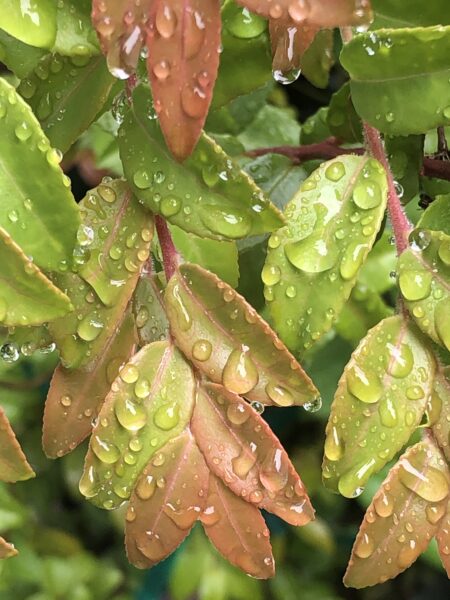
We live in a lush environment. Now that smoke and fire season is behind us we can lean into our wet and cold season. According to the Farmer’s Almanac we are to expect snow, cold, and lots of rain over the last half of November which will wind down into mild temps and rainy days. Their prediction is our temperature will average 48° F this month. How does that stack up to what the weather channel folks predict or what is happening now? Well, as I write, the high temperature for this sunny fall day was 53° F, but the lows this week are dipping into the freezing range. The predictions from AccuWeather are for sunshine this week moving into rain next week for an extended few weeks. Averages in the mid 40’s and lows in the 40’s with an occasional 30 some degree night. This seems rather typical for our area. What’s not as typical is that all the rain will net us more rainfall than our norm. So, expect rain. Lots of it.
What do we do with all that rain? Well to manage copious amounts of rain running off rooftops install a cistern, or a rain garden. Slow the water down, protect our surrounding waterways from pollution coming off our roofs, driveways, and other impervious surfaces and in the case of areas with combined sewers, the sewage coming from our homes. Cisterns can be set up to funnel water, keeping them open during rainy periods to disperse the water more slowly, then closing them up later to use for the garden as the rain fades into summer. Raingardens can be intermediaries between a cistern and the storm drains or act alone and offer the services of a designed wetland in your own front yard. To learn more and to see if you might qualify for specialized rebate programs visit the 12,000 Raingardens website for programs in the area and ideas about how to manage all that rain. The Seattle and King County managed RainWise rebate program can be found at this site as can other local area rebate programs. https://www.12000raingardens.org/
All that rain has to go somewhere and as mentioned sweeps out into our local waterways. But before it gets there it soaks into our yards and neighborhoods. As leaves are also falling, the rain floats them down the streetside gutters and many of them find their way onto the storm drain inlet on your block. Be a good steward and keep the leaves out of your streetside gutters to avoid flooding your street. Join an Adopt-a-Drain program in your area to help with the effort. Leaves are coming down slowly this year as we went from summer to winter pretty quickly without much of a fall period of leaf abscision. Hormonal changes in deciduous plants trigger the letting loose of this year’s leaves while the plant goes dormant. We are going to be cleaning leaves up for awhile. Leaves are great for immediate mulch in your garden, to save and compost into leaf mold and use as mulch next year, and to share with leafless neighbors. Autumn gold! Most jurisdictions allow you to set out extra leaves with your yard and food waste collection bin each fall. Take advantage. Click the link to get signed up in Seattle to Adopt a Storm Drain.
Now, about that soil. Our gardens went dry for months this summer. Then it rained buckets. And it will get back to raining the last half of the month. This sets up some conditions which plant roots don’t do well with. Saturated soils can rot desiccated roots and the damage that is caused can take months and maybe a year or more to see the effects of. A tree that fails “suddenly” could have been in the works for awhile. So, since it is going to rain, keep an eye on your precious trees and shrubs. Evaluating the areas of your yard that stay wet in the winter and dry in the summer can help you plan what to plant for next season that can tolerate summer dry and winter wet soil. Northwest natives generally fit that scenario. Working on improving drainage can go on your plan for next spring’s garden work. And inspecting your plants for signs of decline is super important. Our winters will continue to be drenchers and summer fire and smoke dry season will return as we see the effects of climate change continue. Stay tuned to your garden. Keep an eye on your plants year round and take notes of changes you are seeing.
Consider new plants that are tolerant of these emerging conditions. Species that are adapted to southern Oregon might work. Also some species that already grow here but with phenotypes from warmer climate areas could be the ticket. Some of these have been planted in Washington at Stossel Creek out near Duvall to see how well they adapt. This project shepherded by Seattle City Light and Mountains to Sound Greenway will help us learn more about how we can adapt our landscapes, in our gardens and our forests, to adjust to our changing climate. Learn more about it.
Call us for plant suggestions, for more details on rain, soil, trees and shrubs, and we encourage you to take a rainy day to curl up in your favorite chair and read through plant and seed catalogs this winter.